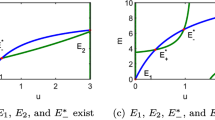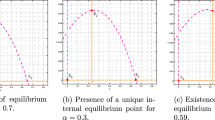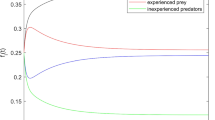Abstract
The main concern of this paper is with survival or extinction of predators in models of predator-prey systems exhibiting group defence of the prey. It is shown that if there is no mutual interference among predators, enrichment could result in their extinction. However, if there is mutual interference, the predator population survives (at least deterministically).
Similar content being viewed by others
Literature
Andrews, J. F. 1968. “A Mathematical Model for the Continuous Culture of Microorganisms Utilizing Inhibitory Substrates”.Biotechnol. Bioengng 10, 707–723.
Aris, R. and A. E. Humphrey. 1977. “Dynamics of a Chemostat in which Two Organisms Compete for a Common Substrate”.Biotechnol. Bioengng 10, 1375–1386.
Beddington, J. R. 1975. “Mutual Interference Between Parasites of Predators and Its Effect on Searching Efficiency.”J. Anim. Ecol. 44, 331–340.
Boon, B. and H. Landelout. 1962. “Kinetics of Nitrite Oxidation by Nitrobacter Winogradski.”Biochem. J. 85, 440–447.
Bush, A. W. and A. E. Cook. 1976. “The Effect of Time Delay and Growth Rate Inhibition in the Bacterial Treatment of Wastewater.”J. theor. Biol. 63, 385–395.
Butler, G. J., H. I. Freedman and P. E. Waltman. 1986. “Uniformly Persistent Systems.”Proc. Am. math. Soc. 96, 425–430.
Erbe, L. H. and H. I. Freedman. 1985. “Modeling Persistence and Mutual Interference among Subpopulations of Ecological Communities.”Bull. math. Biol. 47, 295–304.
Freedman, H. I. 1976. “Graphical Stability, Enrichment, and Pest Control by a Natural Enemy.”Mathl Biosci. 31, 207–225.
—. 1979. “Stability Analysis of a Predator-Prey System with Mutual Interference and Density-dependent Death Rates.”Bull. math. Biol. 41, 167–178.
—. 1980.Deterministic Mathematical Models in Population Ecology. New York: Marcel Dekker.
— and V. S. H. Rao. 1983. “The Trade-off Between Mutual Interference and Time Lags in Predator-Prey Systems.”Bull. math. Biol. 45, 991–1004.
Gilpin, M. E. 1972. “Enriched Predator-Prey Systems: Theoretical Stability.”Science 177, 902–904.
Hassell, M. P. 1971. “Mutual Interference between Searching Insect Parasites.”J. Anim. Ecol. 40, 473–486.
Holling, C. S. 1965. “The Functional Response of Predators to Prey Density and its Role in Mimicry and Population Regulation.”Mem. ent. Soc. Can. 45, 3–60.
Holmes, J. C. and W. M. Bethel. 1972. “Modification of Intermediate Host Behaviour by Parasites.”Zool. J. Linn. Soc., Suppl. 1 51, 123–149.
Huffaker, C. B., K. P. Shea, S. G. Herman. 1963. “Experimental Studies on Predator: Complex Dispersion and Levels of Food in an Acarine Predator-Prey Interaction.”Hilgardia 34, 305–329.
Luckinbill, L. S. 1973. “Coexistence in Laboratory Populations ofParamecium Aurelia and Its PredatorDidinium Nasutum.”Ecology 54, 1320–1327.
McAllister, C. D., R. J. Lebrasseur and T. R. Parsons. 1972. “Stability of Enriched Aquatic Ecosystems.”Science 175, 562–564.
May, R. M. 1972. “Limit Cycles in Predator-Prey Communities.”Science 177, 900–902.
Riebesell, J. F. 1974. “Paradox of Enrichment in Competitive Systems.”Ecology 55, 183–187.
Rogers, D. J. and M. P. Hassell. 1974. “General Models for Insect Parasite and Predator Searching Behaviour: Interference.”J. Anim. Ecol. 43, 239–253.
Rosenzweig, M. L. 1971. “Raradox of Enrichment: Destabilization of Exploitation Ecosystems in Ecological Time.”Science 171, 385–387.
—. 1972a. “Reply to McAllisteret al.”Science 175, 564–565.
—. 1972b. “Reply to Gilpin.”Science 177, 904.
— and W. M. Schaffer. 1978. “Homage to the Red Queen II. Coevolutionary Response to Enrichment of Exploitation Ecosystems.”Theor. Pop. Biol. 14, 158–163.
Schaffer, W. M. and M. L. Rosenzweig. 1978. “Homage to the Red Queen I. Coevolution of Predators and their Victims.”Theor. Pop. Biol. 14 135–157.
Tener, J. S. 1965.Muskoxen. Ottawa: Queen's Printer.
Yang, R. D. and A. E. Humphrey. 1975. “Dynamics and Steady State Studies of Phenol Biodegeneration in Pure and Mixed Cultures.”Biotechnol. Bioengng 17, 1211–1235.
Author information
Authors and Affiliations
Additional information
Research partially supported by the Natural Sciences and Engineering Research Council of Canada, Grant No. NSERC A 4823.
Research partially supported by a Natural Sciences and Engineering Research Council of Canada postdoctoral fellowship.
Rights and permissions
About this article
Cite this article
Freedman, H.I., Wolkowicz, G.S.K. Predator-prey systems with group defence: The paradox of enrichment revisited. Bltn Mathcal Biology 48, 493–508 (1986). https://doi.org/10.1007/BF02462320
Received:
Issue Date:
DOI: https://doi.org/10.1007/BF02462320




